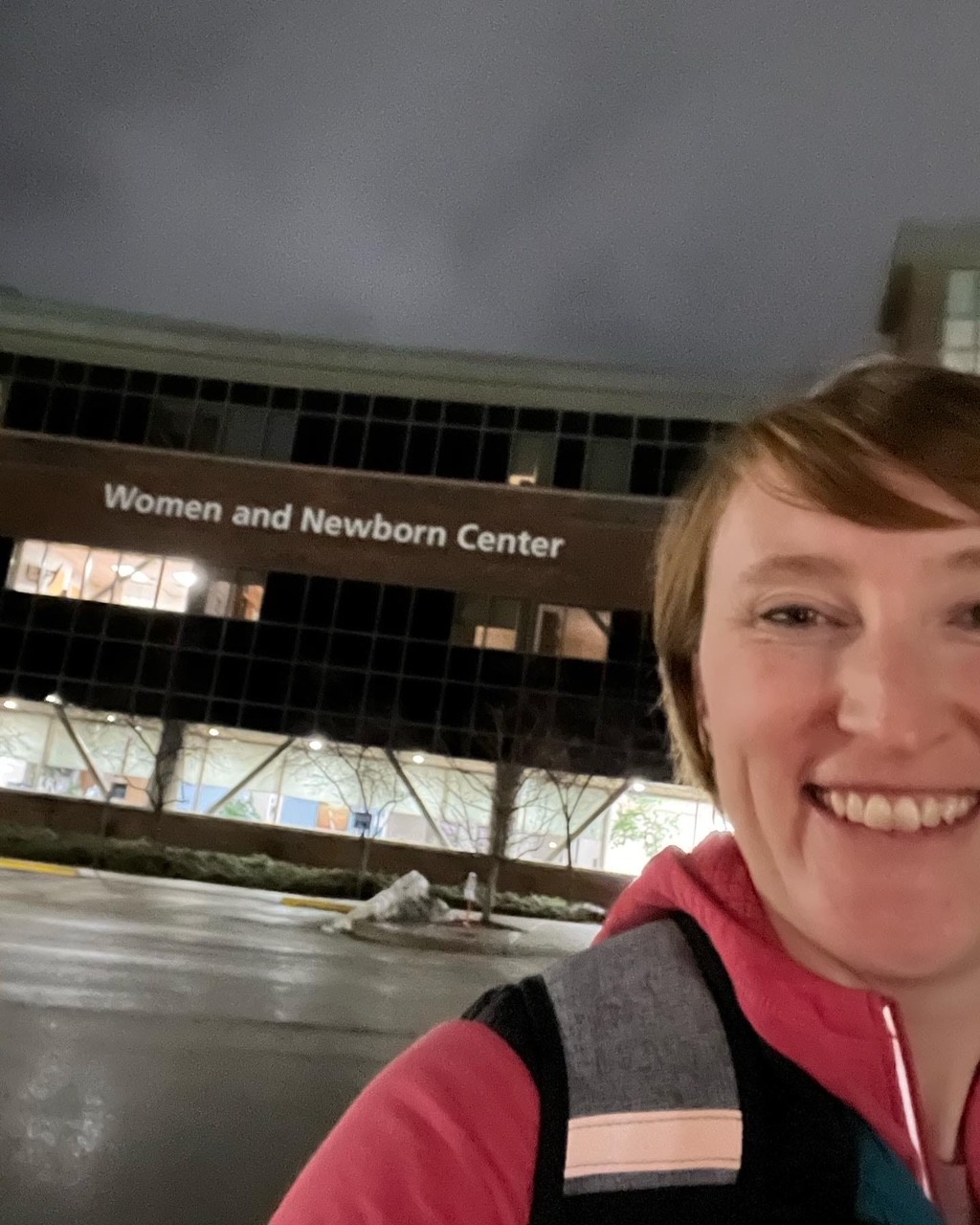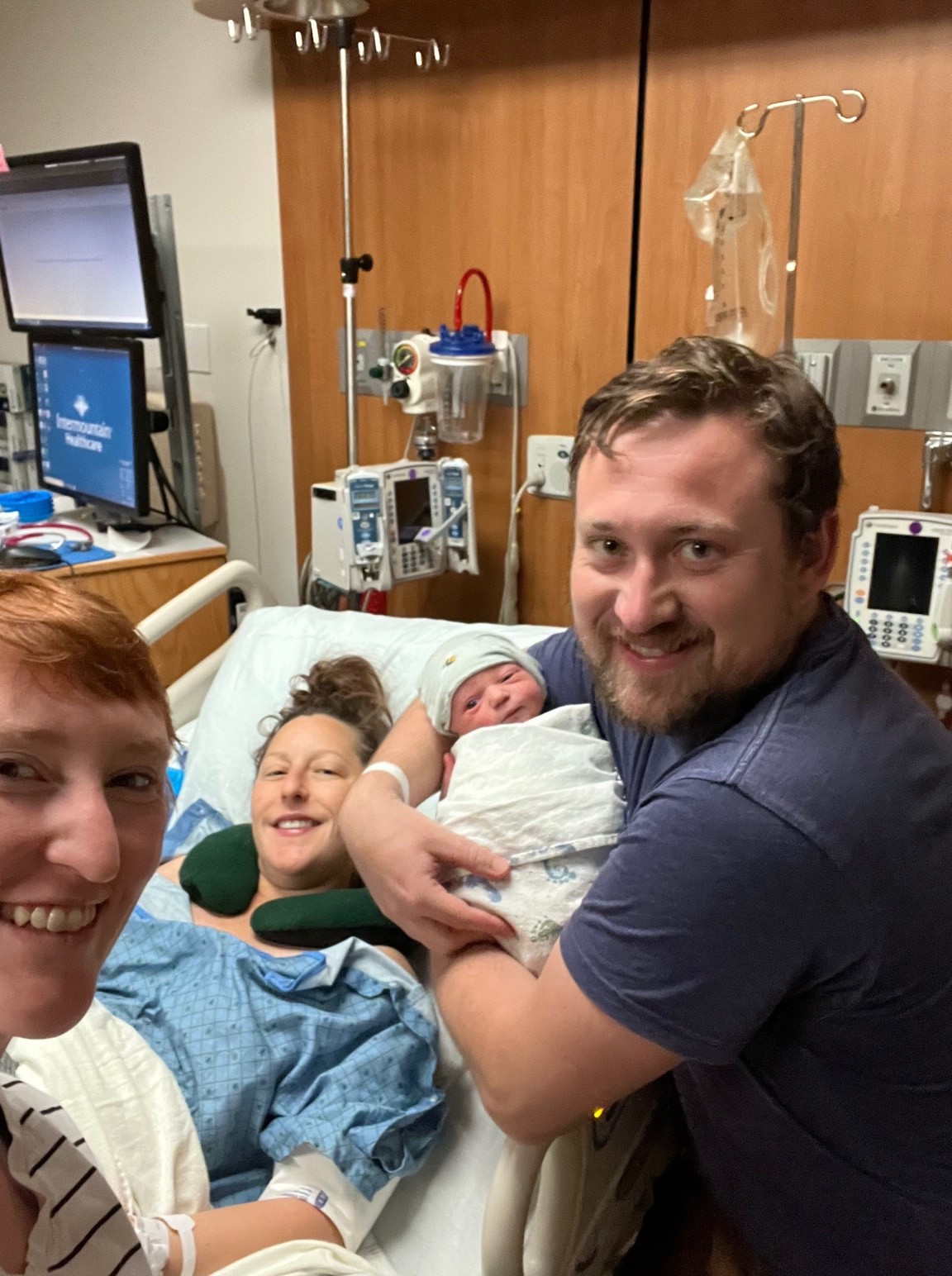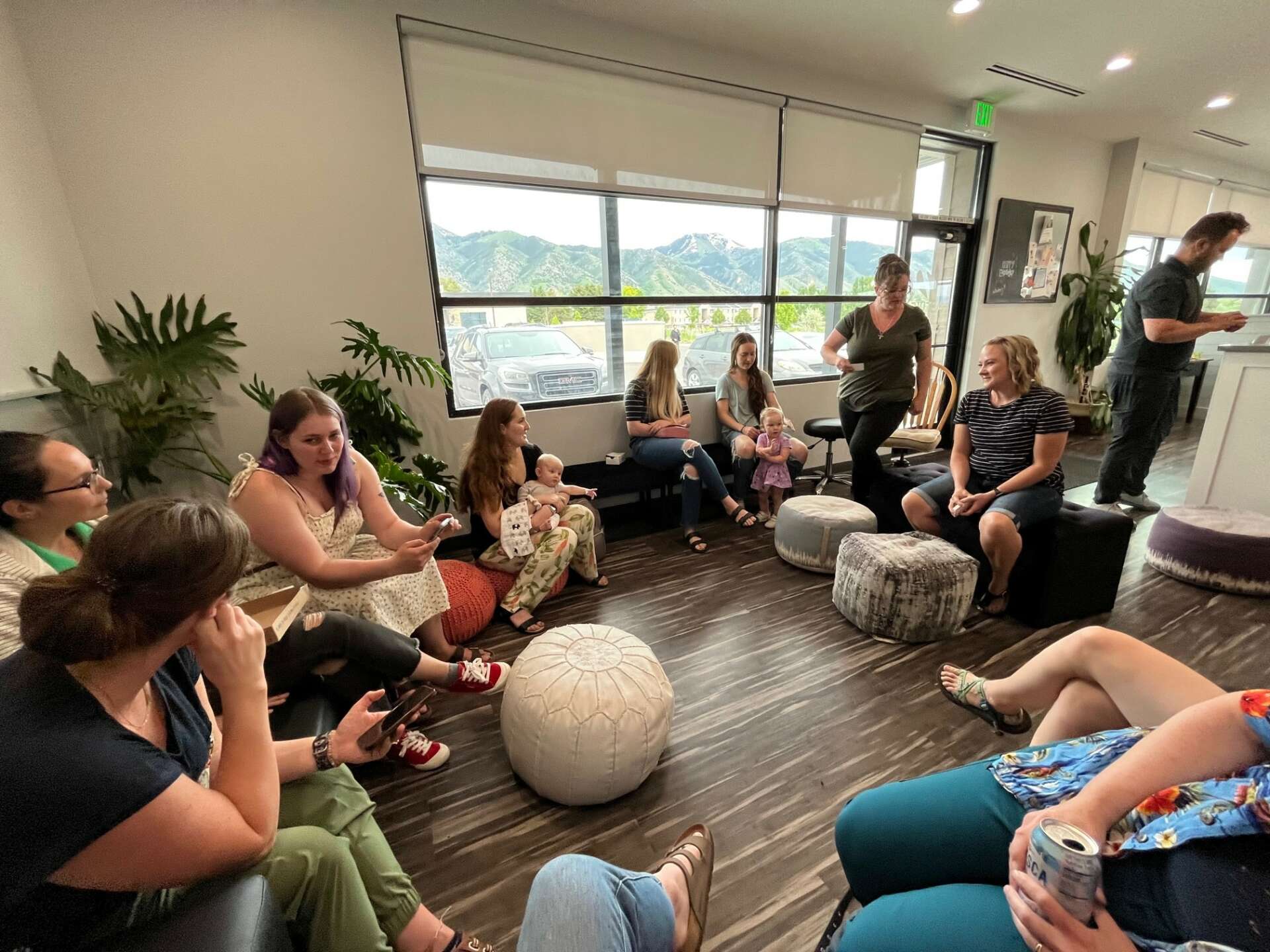Alright – so today we’ve got the honor of introducing you to Hannah Sawitsky Ristorcelli. We think you’ll enjoy our conversation, we’ve shared it below.
Hannah, looking forward to hearing all of your stories today. Setting up an independent practice is a daunting endeavor. Can you talk to us about what it was like for you – what were some of the main steps, challenges, etc.
I was working in a residential treatment center for eating disorders through my first pregnancy and returned to work after my baby was born. I struggled with postpartum anxiety but didn’t recognize it until after the fog had lifted. I remember looking for postpartum support groups and feeling like the care provided to mothers in the postpartum period was severely lacking to the attention and support provided during pregnancy. I became interested in becoming a doula and completed a training that was recommended to me by another birth worker. As I started to work on my business plan to be a doula, I realized that if I was putting in all the work to create a company that I should go all-in and start my private therapy practice. I completed a training in perinatal mood and anxiety disorders and perinatal loss and grief so that I could serve moms as a doula but also as a therapist to navigate the emotional changes through pregnancy and postpartum.
I did something called a “business bootcamp” to help me get the foundation of my business idea in order and then hired a graphic designer to help me create my brand. The money I spent on branding and creating a solid business plan were the best investments I could have made during that time. I was still working full time at my other job as I had to give 3 months notice, but after my daughter went to bed at night I worked on preparing everything for my practice.
Stepping into my own practice was exciting but not without fear. I went through periods of worrying about never getting enough clients. how to value my sessions, debating whether to accept insurance, and questioning whether it was going to work. I was grateful to have surrounded myself with people who could help me stay committed to my vision even when I was having doubts and put my trust in the process. Gradually my practice grew and word of mouth and referrals from previous colleagues helped clients find me.
I am very grateful for the time I had working for an agency to gain clinical experience and expertise and also to make connections with other professionals, and to learn how to collaborate on an interdisciplinary team. Making the transition to my practice was definitely the right choice for me professionally and personally but I couldn’t have been as successful as I was without having a presence in the community. I’ve also learned that working independently requires me to be more intentional about keeping those connections and collaborating with other professionals. It’s not built into my workplace so I have to reach out to other providers and make time to consult and keep those relationships going.


As always, we appreciate you sharing your insights and we’ve got a few more questions for you, but before we get to all of that can you take a minute to introduce yourself and give our readers some of your back background and context?
My name is Hannah Sawitsky, I am a mental health therapist and a doula in Cache Valley Utah. My path to becoming a therapist started long before college. During my adolescent years my parents got involved with an organization called the Boulder Center for Conscious Community. They attended various groups there and started learning the work of Julie Colwell, PhD. As a teenager I was initially pretty irritated when they came home and started talking about “the five feelings” and “speaking the unarguable truth” and “the drama triangle”. Then after a while, I started going to the groups too. I loved the feel of being in the space at the center and also the community (even though I was the youngest person there by 30 years, probably). I didn’t know it then but this experience and Julie’s work (now called the Evolutionary Power Institute) eventually became the foundation for everything I do as a practitioner.
My interest in psychology solidified during my time at Lawrence University in Appleton, WI. I thought I would be a music major and focus on playing French Horn so it was a bit of a shift to major in Psychology and Neuroscience. I became really interested in the brain and soaked up all the really challenging classes about brain and behavior and understanding how people work (sounds cliche). I also had the opportunity when I studied abroad in Melbourne, Australia for a year to get some more advanced neuroscience coursework at a bigger university. I thought that I was going to pursue more in the neuroscience and research realm and actually opted out of a series of undergraduate clinical classes thinking I wouldn’t need them. I did my senior capstone project on why music therapy is an effective treatment for autism spectrum disorder based on the areas of the brain impacted in autism and the areas of the brain activated by music. I loved the project and cited research from Dr. Eric Courchesne at UC San Diego. After living back home in Colorado for a while I applied for an internship at the Autism Center for Excellence.
A funny story, I got accepted to the internship and an email went out saying we had to attend a meeting at the clinic. I was still living in Colorado but took the email seriously and I didn’t want to lose the opportunity so I flew to San Diego with my mom to go to the meeting. The research assistant was pretty surprised I went through the trouble and said I probably could have just called and let them know I was out of state. Regardless it was a good opportunity to see the area and talk in person with the person coordinating the internship. The most valuable thing from the trip was her being very straight forward that moving for this unpaid internship would be risky if they were to lose funding and the project couldn’t continue. She gave me the opportunity to wait to hear about their next funding cycle before making the move, signing a lease, and trying to figure out how to afford living in San Diego for this unpaid position.
While I was back in Colorado waiting I continued to attend groups and workshops at the BC3 and I created the very first BC3 “internship” with Julie (Dr. Colwell). I also ended up volunteering a lot, and by a lot I mean…it’s pretty much all I did. (work for free, again). I volunteered as a mentor with a program called Colorado Youth at Risk that pairs adults with high school freshmen for a year of mentoring and forming relationship. I did a training to be a respite care provider for foster families, and I volunteered at an adaptive outdoor recreation program called the Breckenridge Outdoor Education Center.
I started at BOEC as a winter ski/snowboard volunteer and went on to attend almost their full summer of brain injury alliance camps. At the BIA camps we were paired with participants who had traumatic brain injuries and accompanied them on a ropes course, adaptive cycling, rock climbing, and rafting. I obviously already had a big interest in the brain and how it functions but I loved working with the people. All this time I had been thinking I needed a research internship to ever get into a masters or doctorate program, and instead I ended up at an outdoor recreation program. Look back this is “so me” but I was trying to fit into my idea of what I was supposed to do at the time.
I ended up not going to San Diego because I met the person who I would eventually marry at the BOEC and knew it wasn’t something I was going to walk away from. I also realized that although research interested me, working directly with people and supporting them living their best and biggest life was more my speed than working in a lab.
My partner and I travelled up the West Coast visiting various masters programs I had applied to and we eventually landed in Hillsboro, OR at Pacific University. Through my graduate school internship I was able to gain work experience at a community mental health program called Luke Dorf. I was serving clients experiencing chronic homelessness, schizophrenia, and other severe and persistent mental illnesses. Although I had never pictures working with this population the experience was invaluable. I had a wonderful supervisor that not only taught me clinical skills but also taught me about good boundary setting and balancing home and work life. He would call me at 5:00 if my car was still in the parking lot and tell me to go home, whatever it was could wait until tomorrow (a lesson I still carry with me today). I also had the opportunity to be mentored by some amazing professions including Jennifer Antick, PhD. Turns out my outdoor recreation experience did translate to graduate school as Dr. Antick was working on several projects involving the healing aspects of the outdoors and outdoor recreation. I was able to combine my interest and experience outside with my curiosity about the brain and emotions.
After completing my degree we moved back to the Rocky Mountains, this time to Logan, UT. I started my first job as a “real” therapist at a residential treatment center for eating disorders. This was another opportunity I had never anticipated and once again, passed up an eating disorder class in grad school thinking I would never work with this population. I’ve been humbled over and over again as I’ve been surprised about where my work has taken me and how valuable each opportunity has been.
(see last question on details around starting my practice)
This brings us to the present. I am full time at my practice Nova Therapy and Doula Services. I provide individual, family, and couples therapy in person in Logan, UT and via telehealth. I see the therapeutic process as collaborative and try to bring creativity and playfulness into sessions. We wont always be sitting down in chairs or on the couch talking and looking at each other. We get up and move around and involve our bodies in shifting emotions and building insights. Sometimes we leave the office all together and go for a walk or sit outside. Some of the best part of my job are when clients get “that look” on their face when we’ve discovered something they haven’t realized before, seeing clients take steps toward change even when it is scary, and when they face into emotions they have been avoiding for a long time. My primary goal is to empower each persons innate ability to create the life they want.
As a doula I offer full spectrum services that cover the prenatal, birth, and postpartum periods. As families prepare to welcome a new baby we talk about the emotional and physical aspects of birth and postpartum, educate them on their patient rights so they can ask questions and advocate for themselves with providers, and help them create a birth AND postpartum plan. The aspect of my doula services I’m developing the most right now is postpartum planning. I’ve realized over time that this is an area that gets ignored or minimized. So much planning goes into pregnancy, we’re checking apps every day to see our baby’s development, and getting ready for birth. Once baby is here many families get the deer in headlights feeling….”Now what? They’re just going to let us take this baby home?”. My goal is for more families to step into postpartum feeling prepared and having access to all the sources of support they need.



Other than training/knowledge, what do you think is most helpful for succeeding in your field?
Building relationships!
As a therapist, all the research on treatment interventions points toward the therapeutic relationship being the strongest predictor of success in therapy. I could know all the treatment modalities and every intervention, and those wouldn’t mean anything if I can’t build rapport with my clients, help them feel safe, and seen and heard. Therapy is one of the most vulnerable things a person can do and it has to be a space where they feel like they can reveal the tender parts of themselves or be guided to look at really challenging truths. Without the relationship, these exposures or disclosures don’t happen and you miss out on the growth that happens on the other side.
Professionally you also need relationships. I attribute the initial success of my therapy practice to having connections with other providers in the community. These relationships have been a primary referral source but these are also the people I call on when I need to consult about a client or an issue I’m facing. As a doula, the birth-worker community is so supportive of one another. Another doula told me early on that the mindset is on abundance, not scarcity. There are plenty of opportunities for all of us so instead of competing we can build each other up and then we all benefit.
Building relationships is one of my primary goals for this year and I’ve enjoyed making many more connections and collaborating with other business and organizations which improves the services we can provide to all of our clients.
We’d love to hear a story of resilience from your journey.
One of my favorite poems of all time is called “Royal Heart” by Andrea Gibson. In the poem they wrote this line…
“Call in your royal heart
Tell it bravery cannot be measured by a lack of fear
It takes guts to tremble”
I believe this is true in so many contexts. There is a lot of risk taking and trust that goes into what I do. It was risky to start my own practice I was scared in a different way every day. Would I get enough clients? Was I going to make any money? Do I know enough? My strategy was to meet my fears with trust. Not blind trust, sitting back with no action believing that everything would work out. It was a trust that even though I wasn’t sure where my next step would land, I could keep moving forward. This helped me tolerate a great deal of uncertainty and not be paralyzed by worry. The more it kept working out, the more trust I had that the next hurdle could be resolved as well.
Fear comes up working with my clients too. All of them! Therapy and doula clients. I tell people all the time “My goal isn’t to help you not feel afraid anymore, it’s for you to get really good at feeling afraid so it doesn’t interrupt your life”. I’m still practicing this constantly. In fact, fear is my least favorite feeling. I’m much faster to get mad or even sad before I’ll acknowledge that I’m afraid. However, when I do acknowledge it, I’m able to face into it and find a way through.
Contact Info:
- Website: ThriveWithNova.com
- Instagram: ThriveWithNova and BirthWithNova
- Facebook: ThriveWithNova and BirthWithNova
- Linkedin: linkedin.com/in/hannahsawitsky/
Image Credits
First photo – Shelby Hansen
Under the logo please reference Eleanor Earnhart
Under the picture of the back of the baby’s head and mother please reference Camille Hyatt


